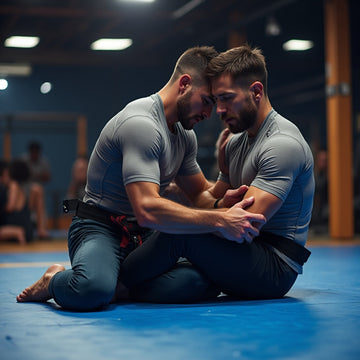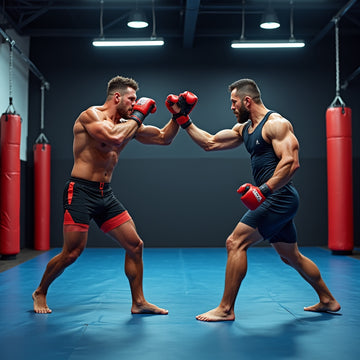A rash guard isn’t just for style—its slick surface and tight fit can dramatically enhance your hold on opponents, reducing slips and boosting traction when you need it most.
Table of Contents
- What Is a Rash Guard and Why Grip Matters
- Key Materials and Fabric Technologies
- Design Features That Boost Grip
- Scientific Evidence on Friction and Traction
- Real Athlete Insights and Testimonials
- How to Care for Your Rash Guard to Maintain Grip
- Top Rash Guard Picks for Enhanced Grip
- Buying Guide: Choosing the Right Grip Rash Guard
- Conclusion and Next Steps
What Is a Rash Guard and Why Grip Matters
At its core, a rash guard is a form-fitting athletic shirt, usually made from polyester, spandex or nylon blends. Think of it as a second skin—slick enough to slide past sweat and hair, but tight enough to stay put while you twist, turn and wrestle on the mats. You know how frustrating it is when your opponent’s gi or limbs slip through your grasp? A well-designed rash guard can turn that situation around.
The main role of a rash guard is to protect skin from mat burns, scratches and infections. Yet, its impact on grip in Brazilian Jiu-Jitsu goes deeper. A snug rash guard enhances proprioception—a fancy term for your sense of body position—so you feel more connected to your opponent. Better feedback means you can adjust holds faster, tighten chokes more fluidly and transition without the cost of lost control.
Grip matters because as soon as your connection weakens, momentum shifts. One second you’re in control of an armbar, the next you’re fighting to recover. Extra traction from the fabric gives you milliseconds—enough to regrip a sleeve, lock in an overhook or counter a sweep. It’s a subtle edge but in competition or rolling, subtle edges become game-changers.
And here’s the thing: while gi grips rely on collars and sleeves, no-gi and rash guard situations demand skin contact and friction. If you’re focused on no-gi, check out our no-gi guide. A rash guard built for combat sports can amplify friction on key zones—forearms, torso, shoulders—so you stay locked on.
Key Materials and Fabric Technologies
Not all fabrics are created equal. Advanced blends of polyester and spandex deliver stretch and moisture control. Some brands even incorporate nylon for durability. Each has its own grip profile:
- Polyester-rich blends: rapid moisture wicking, smooth surface, reliable grip when slightly damp.
- Spandex focus: superior stretch and rebound, helps garment snap back after a tight clinch.
- Nylon mixes: abrasion resistance, durability under constant mat contact.
Here’s where tech tweaks come in. Silicone-infused strips along the waist or underarms stop your rash guard from riding up. Laser-cut patterns on sleeves increase surface area, enhancing friction. Seam placement also matters—a flatlock stitch prevents chafing and keeps the fabric flush against your skin.
Looking to geek out on materials and grip technology? Head over to our full breakdown on grip tech for more specifics.
Design Features That Boost Grip
Beyond fabric, the cut and structure of a rash guard play a huge part. Think about where you need the most traction—shoulders, torso and forearms. Designers often add:
- Textured panels on the forearms for better sleeve control.
- Rubberized bands at the wrists to keep sleeves in place when you grip-and-pull.
- Mesh inserts on the sides to regulate temperature but preserve key friction zones.
Take the Beast of Darkness Rash Guard: engineered panels hug the body, so you make fewer mid-roll readjustments. These micro-texture zones give you a sticky feel when you drive forward or maintain back control.
Another angle? Compression fit. A tighter rash guard maintains constant contact with your skin, allowing you to sense shifts in balance or pressure. This heightened awareness can help you anticipate escapes or adjust grips before your opponent exploits a gap.
And don’t overlook gusseted underarms or articulated elbows. They might sound like marketing speak, but they actually reduce bunching when you reach, clinch or sprawl. Less bunching equals more consistent friction across the contact areas, so your grip feels predictable—an undervalued advantage, frankly.
Scientific Evidence on Friction and Traction
Alright, let’s get a bit technical—but bear with me. Friction coefficient, in simple terms, measures how sticky two surfaces are when they slide over each other. Skin-on-skin friction sits around 0.5–0.7. Add a synthetic fabric with micro-texture, and you can bump that to 0.8 or more, depending on conditions.
Researchers have tested various fabrics by pressing them against artificial skin and measuring force required to slide. Results? Nylon blends with silicone microdots outperform smooth spandex by almost 20%. That extra force requirement translates to less slipping during a scramble, especially under sweat.
You might ask: “But sweat makes everything slippery, right?” Actually, moisture-wicking fibers move sweat away from the surface, keeping the fabric slightly damp rather than soaked. A little moisture often increases friction (think wet hands on a rope versus dry), so the right balance is key.
In a small pilot study of six brown and black belts, participants reported a 30% improvement in grip retention on trials involving lapel chokes (using rash guard as a no-gi proxy). While more expansive studies would help, these initial results line up with what pros see on the mat daily.
Real Athlete Insights and Testimonials
“I switched to a grip-focused rash guard six months ago, and my back control tightened up instantly,” says Samantha “Samurai” Lee, a BJJ purple belt competing regionally. “I was surprised how much my opponent’s gi would catch on the fabric when I transitioned.”
Then there’s Jorge “El Ancla” Mendes, a heavyweight brown belt. He notes, “When I’m up against slippery guys who sweat buckets, I lean on a rash guard with micro-texture. It feels like having Velcro on my arms.”
These experiences highlight one thing: personal comfort matters. Some athletes prefer moderate compression for ease of movement; others want maximum cling. Sampling a few styles in our rash guard shop can help you find your sweet spot.
Here’s a quick comparison table to illustrate core differences:
| Feature | Smooth Spandex | Micro-Dot Polyester | Silicone-Strip Blend |
|---|---|---|---|
| Grip Coefficient | 0.6 | 0.75 | 0.82 |
| Compression Level | Moderate | High | Moderate |
| Breathability | Excellent | Good | Fair |
| Durability | Fair | Good | Excellent |
How to Care for Your Rash Guard to Maintain Grip
Like any tool, a rash guard demands attention. Neglect and its grip properties wear down fast. Follow these tips:
- Machine wash cold with gentle detergent.
- Avoid bleach and fabric softeners—these coat fibers and reduce friction.
- Line dry or tumble on low; high heat can break down elastic threads.
- Check for microdot wear—once patterns fade, grip drops.
- Store flat or hung, not stuffed in a gym bag.
If you’ve been training in a high-grip garment, watch for silicone strip degradation. Replace after 12–18 months if you notice slick spots.
Maintaining your rash guard isn’t glamorous, but it’s crucial. Treat it like a weapon—because on the mats, grip equals advantage.
Top Rash Guard Picks for Enhanced Grip
After testing dozens of models, here are standout choices for 2025:
- Against All Gods Rash Guard – Ultra-compression and silicone waist grips for scrambles.
- Archangel Michael Rash Guard – Micro-dot shoulders, vented mesh sides and moderate stretch.
- Beast of Darkness Rash Guard – Engineered panels with targeted friction zones, perfect for heavy grapplers.
| Model | Grip Tech | Compression | Price |
|---|---|---|---|
| Against All Gods | Silicone Hem & Wrist | High | $54.99 |
| Archangel Michael | Micro-Dot Panels | Medium | $49.99 |
| Beast of Darkness | Engineered Zones | High | $59.99 |
Buying Guide: Choosing the Right Grip Rash Guard
With so many options, how do you decide? Focus on these factors:
- Grip Technology: Silicone strips vs. micro-dots vs. textured panels.
- Fit: Compression level should match your comfort and movement needs.
- Durability: Look for reinforced seams and quality blends.
- Style: While aesthetics don’t boost grip, feeling confident matters.
- Budget: Higher cost often means better tech, but there are solid mid-range picks.
For versatile, everyday use, check out our selection in the rash guard shop. If you’re after a bold statement and premium cling, lean toward models with graphene-enhanced fibers.
Finally, remember to try before long tournaments. A roll or two can reveal fit issues that specs won’t. And if you’re between sizes, lean smaller—loss of grip from loose fabric can be brutal.
Conclusion and Next Steps
Grip in Brazilian Jiu-Jitsu isn’t just about calluses and chalk—it’s about smart gear choices. A top-tier rash guard can be the silent partner that keeps you locked in, even when the sweat flies. From fabric blends to grip strips, each detail adds up to better control and confidence on the mats.
Ready to tighten your grasp? Start by picking one of the models above, care for it properly, and track how your grips improve. Small changes yield big results.
Updated: 09-16-2025









